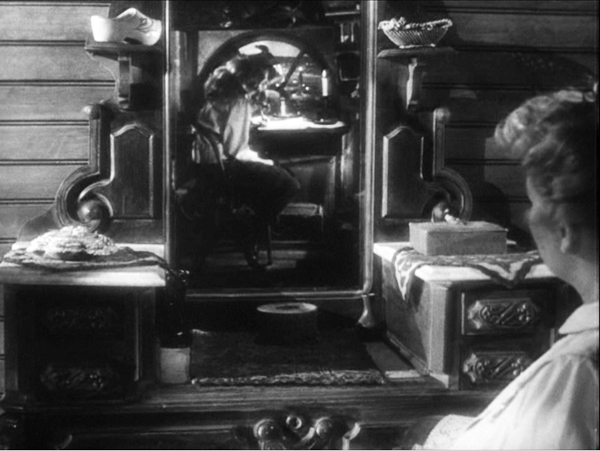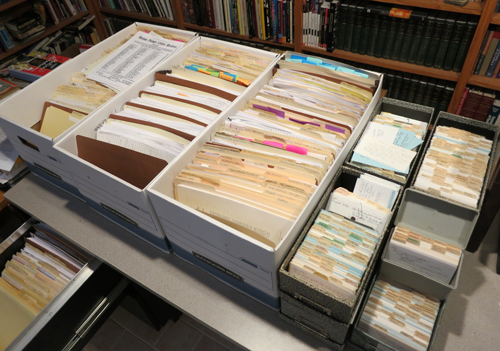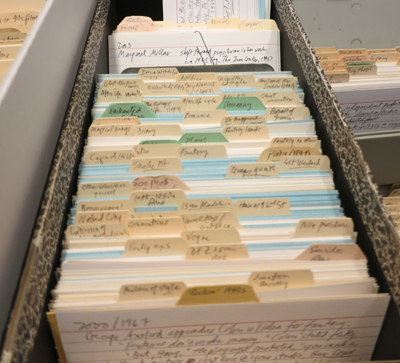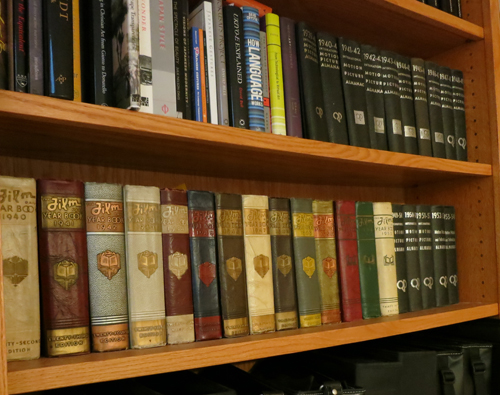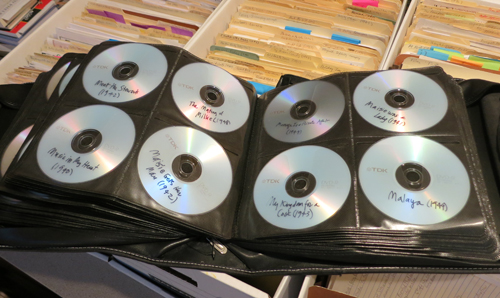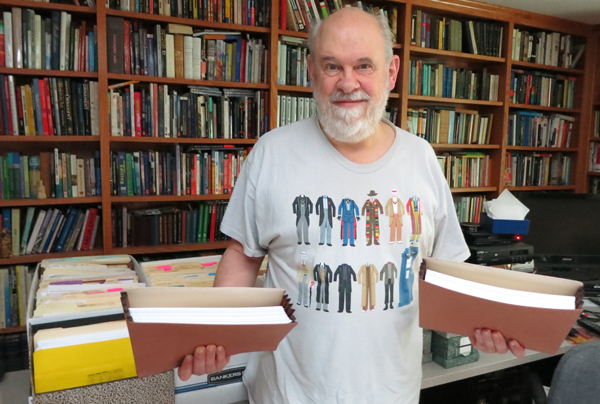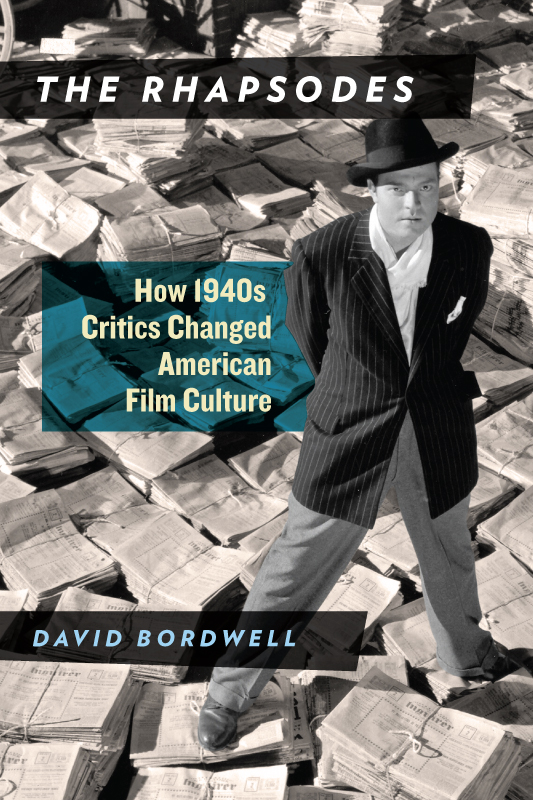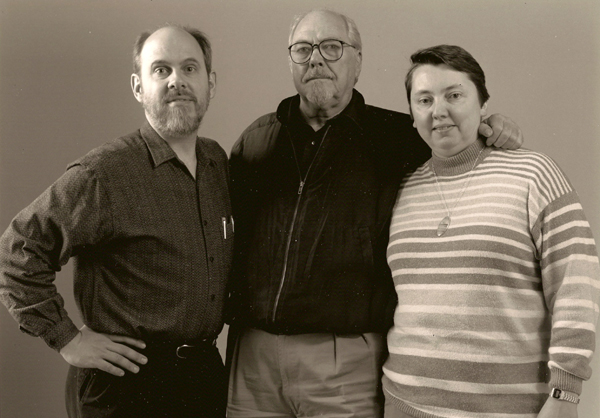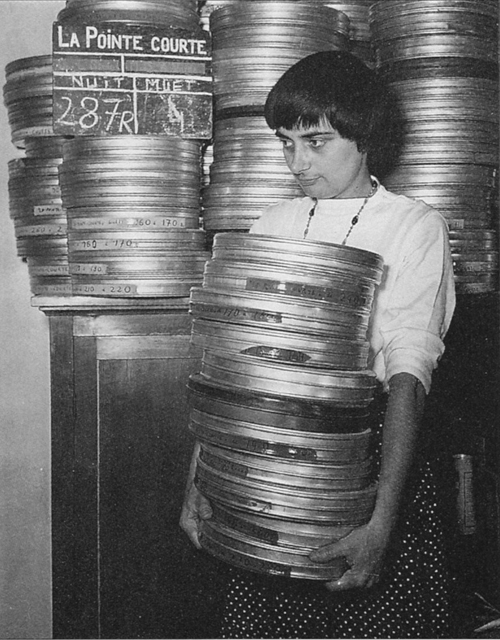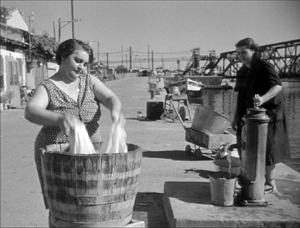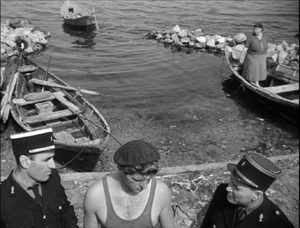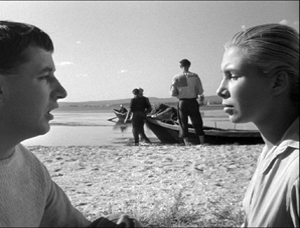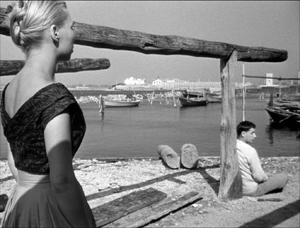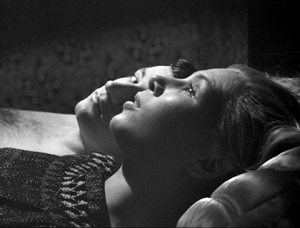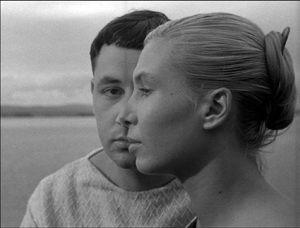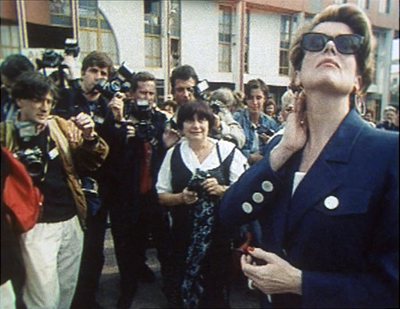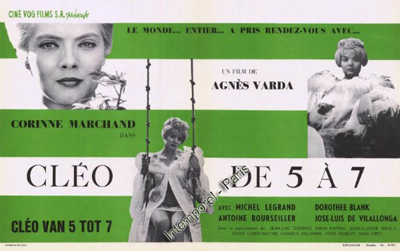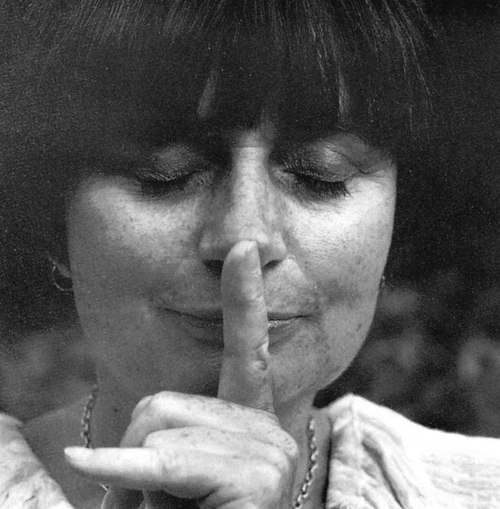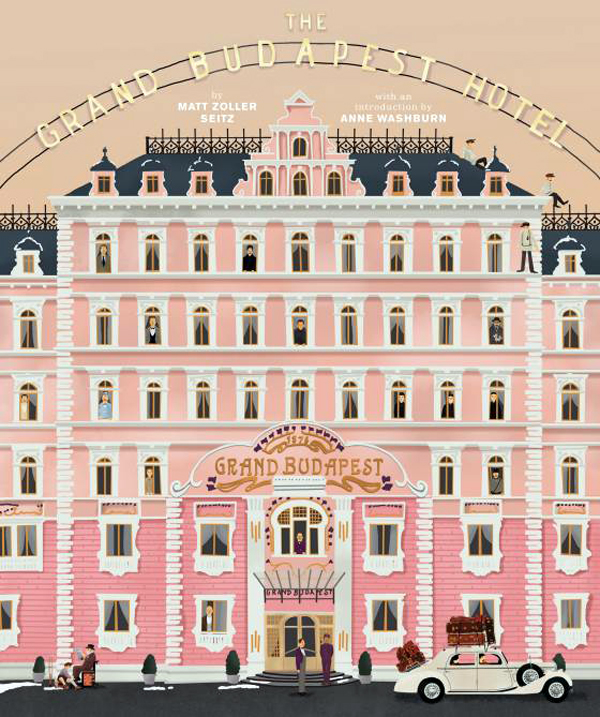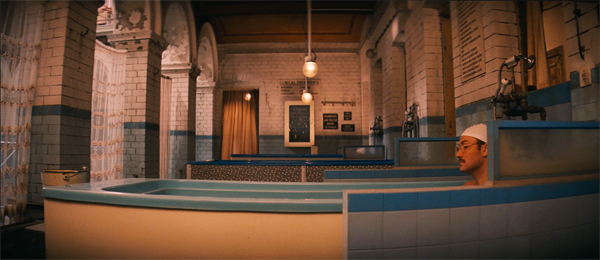Archive for the 'Books' Category
Oof! Out!
I Remember Mama (1948).
DB here:
Jim Naremore calls 1940s American studio cinema “the beating heart of Hollywood.” I think he’s right. For about five years I’ve been working on a book taking EKGs of that beating heart. The book tries to understand some factors that made Forties Hollywood so dynamic and continually captivating.
Doing this called my attention to so many things: the fresh subject matter, the variations in genres, the stylistic experiments, the superb performances, the quality of line-by-line writing. But I focused on something that’s still pretty big: new, or newly revived, storytelling methods. Those methods made that period exciting–not just in film noir, where we tend to think that narrative got pretty wild, but also in melodramas, rom-coms, musicals, and the rest.
It’s the only study I know of how narrative techniques emerged and developed in a single era. No wonder it took five years. I watched over 600 films. I trawled through books and trade papers for hints about what the producers, directors, and writers thought they were doing. And because a lot of techniques weren’t unique to film (e.g., flashbacks, first-person voice-over, etc.), I wound up reading forgotten plays and neglected novels, while listening to hours of old-time radio.
The project started when I was asked to do a series of lectures, “Dark Passages,” for Belgium’s Summer Film College in 2011. Just before that, I tried out some ideas in some spring blog entries. Things crystallized in 2013, when I firmed the project up. In this entry, I promised, falsely, that the book would be short.
Since then, I’ve been immersed in fun, except for the Red Skelton movies. I loved having Mercury Theatre playing in my car during drive-time, and digging out 1930s and 1940s books from the oldest section of our university library.
I think the book says some new things about films of the period, and about the development of American popular entertainment more generally. For one thing, I think I have a better understanding of how High Modernist techniques (out of Joyce, Woolf, etc.) made their way into mass art. (Not directly, I’m convinced.) For another, I have a new respect for those filmmakers who tried something daring, even if–see my last post on The Chase (1946)–they somewhat botched it. And it develops some ideas I floated in The Way Hollywood Tells It: ideas about how modern filmmakers like Tarantino and Nolan are continuing a Forties tradition of somewhat experimental narrative.
Reinventing Hollywood: How 1940s Filmmakers Changed Movie Storytelling went off to the publisher this afternoon. Said publisher is the University of Chicago Press, who did a fine job with our Minding Movies and my recent little book The Rhapsodes, to which this is sort of a bigger, thuggier brother.
In the meantime, just to give you an idea of how one writer makes a book, I append some images from the workbench, before I pack up the paperwork. Here are the file folders and note cards I worked from. Hard to get those long note-card boxes nowadays; I needed 8 1/2 for this project.
Yes, I’m still a pen-and-paper nerd. All that’s changed since my 60s student years is the worsening of my handwriting.
Like you, I have hundreds of digital files too.
I was reliant on my old friends, The Motion Picture Almanac and The Film Daily Yearbook.
I amassed many albums of DVDs, as you’d expect–thanks chiefly to Turner Classic Movies.
Of course there are scores of books about films and figures of the period. I depended a lot on two key surveys: Douglas Gomery’s Hollywood Studio System (both editions) and Tom Schatz’s Boom and Bust: American Cinema of the 1940s. I didn’t rely much on all those books of a reflectionist, Zeitgeisty flavor–for reasons I’ve indicated here as well as in the book.
Reinventing Hollywood should be out this time next year. It should run to around 550 pages, with 180 illustrations. In addition, I’ll be putting up a dozen or so clips online to supplement some of my analyses. Hereabouts, from time to time I’ll preview arguments in the book.
I want to thank my editor, Rodney Powell, and his colleagues at the University of Chicago for supporting the book. I also owe a debt to Jim Naremore, Jeff Smith, and Malcolm Turvey for their close reading of the thing in draft form, and of course to Kristin for help in matters big and small. The couple dozen of friends and colleagues who helped me, too many to list here, are gratefully acknowledged in the text.
To give you a sense of what the book is up to, I’ve gathered most of my Forties blog entries into a separate category. Some of these are grist for the book, and some, like the ones on The Magnificent Ambersons and on The Chase, expand the book’s analysis.
In all it reminds me of what the Duke of Gloucester said to Gibbon: ““Another damn’d thick, square book! Always, scribble, scribble, scribble! Eh! Mr. Gibbon?” I’ve used this before, but after writing or rewriting seven books since I retired in 2004, it seems even more grimly appropriate. The reader is warned.
Photo by Kristin Thompson.
Threefer
DB here:
First, there’s this:
http://isthmus.com/screens/movies/film-scholars-david-bordwell-and-kristin-thompson/
Thanks to Laura Jones and the Isthmus staff for this profile. Among the stills they didn’t use is one of Kristin and me with Robert Altman. I interviewed him for a screening of The Player at the Walker Art Center in 1992. Why waste the scan? I thought, so I put it below.
Second, there’s the pleasant fact that my book The Rhapsodes will be available on 4 April, Kristin’s birthday. It’s an essayistic study of four American film critics who, I think, prepared the way for the film-reviewing explosion of the 1960s.
I like to say that good film criticism offers not only opinions but information and ideas. Otis Ferguson, James Agee, Manny Farber, and Parker Tyler met that standard. The book tries to show that they had intriguing notions about American cinema and its aesthetic. They were superb writers as well. Although each man’s style was unique, they all wrote with a gleaming exuberance. The result, as the title suggests, is a controlled wildness, a quality captured I think in the book’s epigraph by Robert Lewis Stevenson:
In anything fit to be called by the name of reading, the process itself should be absorbing and voluptuous; we should gloat over a book, be rapt clean out of ourselves, and rise from the perusal, our mind filled with the busiest, kaleidoscopic dance of images, incapable of sleep or of continuous thought.
I’m very grateful to the University of Chicago Press, particularly my editor Rodney Powell, manuscript editor Kelly Finefrock-Creed, and Senior Promotions Manager Melinda Kennedy. Deep thanks as well to my initial readers Jim Naremore and Chuck Maland, and to the people who kindly endorsed the book: David Koepp, Manohla Dargis, and Philip Lopate.
More background on the book is here. I hope to offer some ideas about film criticism today in an upcoming entry.
Third, later this week Kristin and I are moving to Manhattan for three months. (Whoopee!) She’ll be working on her Amarna statuary project with her collaborator, a curator at the Metropolitan Museum of Art. I’ll be doing research, mostly on Hollywood in the 1940s, while watching movies, seeing friends, and blogging. I’ll give some talks as well. One, presented at Sacred Heart University and at Tufts, is drawn from the 1940s book. I’ll discuss The Rhapsodes at the 92nd Street YMCA and the Museum of the Moving Image in Astoria (details on the last yet to be finalized). Maybe I’ll see you at one of these get-togethers?
Photo: Walker Art Center, Minneapolis.
Still Agnès
Self-portrait by Agnès Varda.
DB here:
Sixty years ago, a twentysomething photographer released a film shot in an out-of-the-way French fishing village. Coming right after Rossellini’s Voyage to Italy and Fellini’s La Strada (both 1954), the result announced something new in cinema. Like those other works, it looked forward to the French Nouvelle Vague and the cinematic modernism of Antonioni, Bergman, and a host of other filmmakers.
But the status of Agnès Varda’s La Pointe Courte (1955) became apparent only with the most distant hindsight. It didn’t win big attention on the festival circuit, in the international market, or in the pages of highbrow film magazines. Denied a commercial release, La Pointe Courte circulated mostly in French ciné-clubs. In the early 1980s, when I saw it at the Brussels Cinematek, it was still a rarity.
Thirty years after La Pointe Courte, Varda’s career reached a new level. Vagabond (Sans toi ni loi, 1985), widely recognized as her masterpiece, remains one of the great achievements of that modern cinema she helped create. And she hasn’t exactly been idle since. There have been many films both long and short, including a biopic of her husband Jacques Demy in Jacquot de Nantes (1991) and the picaresque The Gleaners and I (2000); the fascinating autobiography Varda par Agnès (1994); and over the last decade a series of installations in museums around the world. She started as a photographer, became a cinéaste, and is now a plasticienne, a maker of painting and sculpture.
She is eighty-seven years old.
Agnès V., not B.
Our colleague Kelley Conway has just published an authoritative consideration of the work of this shrewd, unpredictable survivor. Reading Kelley’s book reminded me of that encounter with La Pointe Courte.
I had known Varda’s more famous works: Cléo from 5 to 7 (1961), screened at my college film society as the project of a New-Wave fellow-traveler; Le Bonheur (1965), which might be called Jules et Jim revisé et corrigé; One Sings the Other Doesn’t (1977), which got circulation among other feminist films of the period. These didn’t prepare me for La Pointe Courte’s daring mix of realism and minimalism. Varda wanted, she said, to make a film that was the equivalent of a difficult book, and for me she succeeded.
The film alternates sunny images of local life—fishing, net-mending, washing-up, a festival—with episodes in which a Parisian couple drift through the village, oddly detached from the life around them. The everyday scenes are shot in documentary style, but with a casual rigor suggesting Cartier-Bresson. Meanwhile, the couple talk in stylized compositions that could only remind me of L’Avventura.
No wonder Picasso was Varda’s favorite painter: she splits up the couple’s faces with cubistic zeal.
The disjunction between the actuality of a location and the abstraction of the couple’s anomie-riddled duet, often heard only as voice-over commentary, looks forward to Hiroshima mon amour. (No wonder: Resnais edited the film.) I barely understood the French, but the film gripped me. It was of great historical interest, and it had its own stubborn vivacity. When Kristin and I planned the first edition of Film History: An Introduction (1994) I made sure it got in. In that year, forty years after it was made, La Pointe Courte was released on VHS.
Things change. Varda is now regarded as a living treasure of world cinema, preserved in excellent Criterion DVD editions, available for streaming on Hulu, and wrapped up in a vast cube, Tout(e) Varda (20 features, 16 shorts). Whatever she does in the future, we can at least take a long-distance measure of her accomplishments.
The dream of many writers on a single director is to cover it all: appreciative study of the films, background on how the films came to be, assessment of their immediate impact and long-range influence. But this breadth of understanding is very hard to achieve. Where are the documents? How do you get the filmmaker to talk?
Kelley has done it. Her book combines film analysis, historical research, and information drawn from Varda’s archives. Kelley can tell us how the films came to be, what Varda wanted to accomplish, and how they were received. To top it off, there’s a new interview with Agnès herself.
Crossing landscapes
Les Demoiselles ont eu 25 ans (1993): Varda and Deneuve.
With a brisk practicality echoing that of her subject, Kelley has focused her lens tightly. You can’t quarrel with her choices: La Pointe Courte, the early short documentaries, Cléo, Vagabond, The Gleaners, two installations, and The Beaches of Agnès (2008). Her plan of attack is straightforward: scrutinize the film, then work backward to the conditions of production and forward to the film’s reception.The analyses are models of attention to story and style, images and sounds. Kelley pins down what intrigued me about the acting in La Pointe Courte, showing its debt to Brechtian distancing (a big influence on Varda). She goes on to connect the performances to the experiments in “flat” performance we find in Tati and Bresson at the same period. Kelley shows how many of Varda’s artistic strategies, such as whimsical puns and a love of digression, go back to her early documentaries.
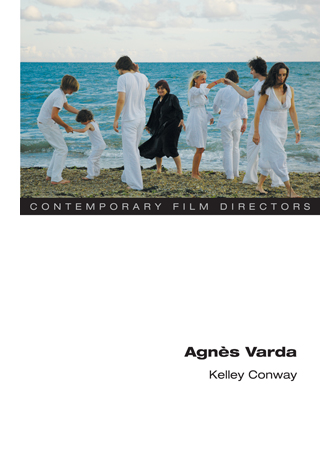 In a sense, Varda has never ceased to be a documentarist, since all her films depend on a process of research, exploration, and a personal viewpoint characteristic of the roving photographer. The book includes fresh information on two of Varda’s major multimedia installations, obviously born of her interest in found materials, gags, and unexpected juxtapositions. For one, Varda covered the gallery floor with 1500 pounds of potatoes and played the role of “Lady Potato.” Another exhibition included a reference to the grave of her beloved cat Zgougou. As described by Kelley, these installations are less narcissistic than they might seem, because Varda’s work has always been personal, derived from her perceptions of her subject. Even The Gleaners, which is at one level a denunciation of a society built on waste and inequality, is refracted through the filmmaker’s sense of aging. And though Mona in Vagabond is ferociously solitary, we meet her through Varda’s welcoming voice-over: “It seems to me she came from the sea.”
In a sense, Varda has never ceased to be a documentarist, since all her films depend on a process of research, exploration, and a personal viewpoint characteristic of the roving photographer. The book includes fresh information on two of Varda’s major multimedia installations, obviously born of her interest in found materials, gags, and unexpected juxtapositions. For one, Varda covered the gallery floor with 1500 pounds of potatoes and played the role of “Lady Potato.” Another exhibition included a reference to the grave of her beloved cat Zgougou. As described by Kelley, these installations are less narcissistic than they might seem, because Varda’s work has always been personal, derived from her perceptions of her subject. Even The Gleaners, which is at one level a denunciation of a society built on waste and inequality, is refracted through the filmmaker’s sense of aging. And though Mona in Vagabond is ferociously solitary, we meet her through Varda’s welcoming voice-over: “It seems to me she came from the sea.”
Another legacy of documentary: Kelley points up how even the fiction films spring from an attention to the specifics of a locale. “Part of Varda’s journey is regularly exploring a chosen region at length, waiting for ideas, emotions, and images to emerge.” That region might be a single Parisian street (L’Opéra-Mouffe, 1958; Daguerréotypes, 1975) or the fourteenth arrondissement (Cleo from 5 to 7). Like La Pointe Courte, Cleo is the story of a walk, this time purportedly played out in actual duration as a beautiful pop singer awaits the results of a test for cancer. Mona, in Vagabond, is another wanderer, and the wintry bleakness of southern France is as central to the action as whatever psychology we can find in her or the people she meets. The Gleaners and I searches out people who stalk the landscape and live off what they can scavenge. With modern cinema from Bicycle Thieves onward, Dwight Macdonald once noted, “The talkies have become the walkies,” but Varda has always embedded her footloose protagonists in the particulars of place.
Varda’s personal archive has given Kelley the opportunity to document the director’s creative process. The scripts are sometimes scrapbooks, with texts and images jostling one another. (Kelley offers an example in a 2011 blog entry.) The arrival of digital tools reinforced and expanded Varda’s method of free assembly. Out of a database of images, Varda erected the scaffolding of The Beaches of Agnès before starting her screenplay. She wrote, shot, and edited the whole thing in a nonlinear fashion. During the final stages, two editors worked busily in separate rooms. “I went from one to the other. On one side was Sète and Los Angeles, in the other room was Belgium and Paris.”
As for exhibition, crucial to Varda’s early films was a distinctive French institution. Varda had created her company to make shorts, but when La Pointe Courte grew to 80 minutes, it could not be distributed under those auspices without new investment. As a result, it found its main audience in the network of ciné-clubs that had grown up after World War II. That network became activated to the maximum during the release of Cleo from 5 to 7. One of the side benefits of Kelley’s book is its explanation of the power that the ciné-club scene had achieved by the early 1960s.
Brandishing the slogan “Develop Film Taste, Introduce Masterpieces, Educate the Public,” an astonishing five hundred clubs with over two hundred thousand members showed thousands of films in the year that Cleo was released. Varda took advantage of this situation to promote her film, but Kelley goes beyond the simple marketing issue to point out that the clubs bolstered spectators’ appreciation of New Wave films. She draws on audience comments to show that the organizers guided audiences to talk about form, style, theme, and historical context. The clubs helped create the “demanding viewer” described by Alain Resnais: a viewer eager for challenging films that could bear comparison to advanced works in traditional arts.
Varda’s later films were absorbed into the mainstream commercial distribution/exhibition infrastructure, and Kelley is painstaking in plotting critical response to them. Near the book’s close, she traces how another institution shaped Varda’s work: the museum. Kelley shows how the emerging importance of installation art encouraged filmmakers like Varda and Chris Marker to create multimedia exhibits that were natural continuations of their poetic-essayistic documentaries. The installations seem to have encouraged Varda to take up the autobiographical compilation mode that yielded The Beaches of Agnès.
There is much more in Agnès Varda than I can summarize, but I hope I’ve piqued your interest. For any lover of Varda, Kelley’s book is a must, and even casual viewers will learn things that will drive them to the films. Reading it led me to think about how Varda’s lack of cinephile culture (she emphasizes that she knew nothing of film when she started) allowed her to respond to stories more directly than did the Bad Boys of the Cahiers, who saw everything through a mesh of hundreds of other movies. I was also prodded to think of her as quite an innovator in narrative. She has given us the parallel structure of La Pointe Courte, the fantastic science-fiction plot of Les Créatures, the isoceles love triangle of Le Bonheur, the dual-protagonist structure of One Sings, and the network narrative of Vagabond, with Mona as a circulating object a bit like Bresson’s Balthazar.
From the delightful interview with Lady Potato herself, I allow myself just one spoiler:
KC: You seem to start your projects with considerable preparation but you also have a flair for improvisation. Do you see it that way also?
AV: Yes and no. Or no and yes, depending.
An earlier entry discusses a Kelley talk on La Point Courte. I discuss some ambiguous narrative cues in Vagabond in my updated “Art Cinema” essay in Poetics of Cinema, 166-169.
This has been a good publishing year for our colleagues at Wisconsin–Madison. Lea Jacobs’ book on filmic rhythm came out last winter; go here for our observations.
Rebooking at THE GRAND BUDAPEST HOTEL
DB here:
I didn’t plan it, but this has been the year of Wes Anderson on our blog.
After an entry on The Grand Budapest Hotel and its play with aspect ratios, I posted an analysis of Moonrise Kingdom (my favorite Anderson movie). Now comes a book from the indefatigable Matt Zoller Seitz that continues the work of his splendiferous Wes Anderson Collection.
Matt provides critical commentary, natch, along with many interviews with Anderson and his creative team. Some critics have a look-in as well. I add my $.02.
You can read more on Vulture here. Available from Abrams on 10 February–too late for the December holidays, but well ahead of Valentine’s Day.












